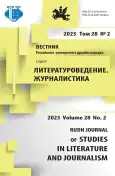Czech Republic television: genre and thematic features of TV news in 1989-2021
- Авторлар: Lapuk E.V.1
-
Мекемелер:
- Lomonosov Moscow State University
- Шығарылым: Том 28, № 2 (2023)
- Беттер: 306-317
- Бөлім: JOURNALISM
- URL: https://journal-vniispk.ru/2312-9220/article/view/318906
- DOI: https://doi.org/10.22363/2312-9220-2023-28-2-306-317
- EDN: https://elibrary.ru/QJNFRY
- ID: 318906
Дәйексөз келтіру
Толық мәтін
Аннотация
The author applies the content analysis to study 1608 video news of the Czech TV in 1989, 2005 and 2021. The studies of two categories “Genre” and “Thematic” were conducted. The hypotheses about the increase of negative information in TV news and the rise of entertainment content is tested. Much attention is given to seeking changes in the genres of TV news, which occur as a result of media convergence and the expansion of user-generated content. The greatest genre diversity was found in the modern period (2021), the lowest genre diversity was noted in 1989, when seven out of ten media texts were prepared in the “short note” genre. User-generated content brought only minor changes to the TV news genres. Over time, the role of PR-texts in TV news increases: the number of announcements increases more than tenfold between 1989 and 2021. Previous research indicate that mass media have a tendency to focus on violent and negative content. In the context of the TV news topics, it is demonstrated that nowadays there is an increase to some extent in news on crime and incidents and a slight decrease of the political agenda compared to 1989. Besides, it is reported that the number of sports TV news has significantly decreased, that confirms the trend of differentiation of the audience by TV programs focused on a single subject and specialty (or cable) channels.
Негізгі сөздер
Авторлар туралы
Ekaterina Lapuk
Lomonosov Moscow State University
Хат алмасуға жауапты Автор.
Email: lapukate@yandex.ru
ORCID iD: 0000-0003-2231-3596
PhD student, Department of Television and Radio Broadcasting, Faculty of Journalism
9 Mokhovaya St, bldg 1, Moscow, 125009, Russian FederationӘдебиет тізімі
- Arbaoui, B., De Swert, K., & Van der Brug, W. (2020). Sensationalism in news coverage: A comparative study in 14 television systems. Communication Research, 47(2), 299-320. https://doi.org/10.1177/0093650216663364
- Bruckmaier, M., Tachtsidis, I., Phan, P., & Lavie, N. (2020). Attention and capacity limits in perception: A cellular metabolism account. Journal of Neuroscience, 40(35), 6801-6811. https://doi.org/10.1523/JNEUROSCI.2368-19.2020
- Chobanyan, K., & Nikolskaya, E. (2021). Testing the waters: TikTok’s potential for television news. World of Media. Journal of Russian Media and Journalism Studies, 3(3), 62-88. http://doi.org/10.30547/worldofmedia.3.2021.3
- Chobanyan, K.V. (2016). Genre priorities of a modern news channel (a case study of the CNN and Rossiya 24) (PhD thesis). Moscow: Moscow State University. (In Russ.)
- Чобанян К.В. Жанровые приоритеты и языковая модель современного информационного телеканала (на примере каналов Си-эн-эн и «Россия 24»): дис. ... канд. филол. наук. М., 2016. 235 с.
- Dolgova, Y.I., & Peripechina, G.V. (Eds.). (2021). Television journalism. Moscow: Aspekt Press. (In Russ.)
- Телевизионная журналистика / под ред. Ю.И. Долговой, Г.В. Перипечиной. М.: Аспект Пресс, 2021. 208 с.
- Dolgova, Y.I., Peripechina, G.V., & Tikhonova, O.V. (2019). Content strategies of the “Big Three” TV channels: Topics, genres, format. Tomsk State University Journal of Philo- logy, (61), 237-255. (In Russ.) https://doi.org/10.17223/19986645/61/14
- Долгова Ю.И., Перипечина Г.В., Тихонова О.В. Контент-стратегии телеканалов «большой тройки»: тематика, жанры, форматы // Вестник Томского государственного университета. Филология. 2019. № 61. С. 237-255. https://doi.org/10.17223/19986645/61/14
- Dvořák, L. (2001). Česká televize - věc veřejná, aneb, Zápisky teroristovy. Brno: Jota.
- Fridrich, M. (2022). Zpráva o programu ČT1 v roce 2021. Praha: České televise.
- Furqan, R., Muhtar, S.M., & Arya, N. (2022). Application of user generated content by television news’ during pandemic. Jurnal ASPIKOM, 7(1), 71-83. http://doi.org/10.24329/aspikom.v7i1.1069
- García-Avilés, Jose A. (2020). Reinventing television news: Innovative formats in a social media environment. Journalistic Metamorphosis, 70, 143-155. https://doi.org/10.1007/978-3-030-36315-4_11
- Jensen, K.B. (2022). Media convergence: The three degrees of network, mass, and interpersonal communication. London: Routledge. https://doi.org/10.4324/9781003199601
- Jiang, Y. (2022). The transition and countermeasures of traditional media after being impacted by the advent of digital media. Proceedings of the 2022 8th International Conference on Humanities and Social Science Research (ICHSSR 2022) (pp. 2237-2242). Beijing: Atlantis Press. https://doi.org/10.2991/assehr.k.220504.405
- Keib, K., & Wojdynski, B. (2019). Staying alive: TV news facebook posts, perceived credibility, and engagement intent. Electronic News, 1(1), 3-22. https://doi.org/10.1177/1931243118767733
- Lotz, A.D., Eklund, O., & Soroka, S. (2022). Netflix, library analysis, and globalization: Rethinking mass media flows. Journal of Communication, 72(4), 511-521. https://doi.org/10.1093/joc/jqac020
- Nikolskaya, E.S. (2016). TV news magazines and evening news: Similarities and differences. Herald of Vyatka State University, (8), 92-101. (In Russ.)
- Никольская Э.С. Телевизионные журналы новостей и вечерние новости: сходства и различия // Вестник Вятского государственного гуманитарного университета. 2016. № 8. С. 92-101.
- Porten-Cheé, P., & Eilders, C. (2019). Fragmentation in high-choice media environments from a micro-perspective: Effects of selective exposure on issue diversity in individual repertoires. Communications, 44(2), 139-161. https://doi.org/10.1515/commun-2018-2013
- Rudenko, M.O. (2014). Negative information in mass media and it's influence on people. Mediaobrazovanie, (2), 108-112. (In Russ.)
- Руденко М.О. Негативная медийная информация и ее влияние на людей // Медиаобразование. 2014. № 2. С. 108-112.
- Savolainen, R. (2022). Infotainment as a hybrid of information and entertainment: A conceptual analysis. Journal of Documentation, 78(4), 953-970. https://doi.org/10.1108/JD-08-2021-0169
- Volkova, I.I., Proskurnova, E.L., & Tran Thi Thuy Dung. (2021). Prospects of news television: Materials of in-depth interviews. Nauchnyi Dialog, (3), 157-170. (In Russ.) https://doi.org/10.24224/2227-1295-2021- 3-157-170
- Волкова И.И., Проскурнова Е.Л., Чан Т.Т. О перспективах новостного телевидения: материалы глубинных интервью // Научный диалог. 2021. № 3. 157-170. https://doi.org/10.24224/2227-1295-2021-3-157-170
- Vyrkovsky, A.V., Galkina, M.Y., Kolesnichenko, A.V., Obraztsova, A.Y., & Vartanov, S.A. (2019). Russian newsrooms in digital era: Challenges and prospects. Russian Journal of Communication, 11(1), 37-52. https://doi.org/10.1080/19409419.2019.1580607
- Wardle, C., & Williams, A. (2010). Beyond user-generated content: A production study examining the ways in which UGC is used at the BBC. Media, Culture & Society, 32(5), 781-799. https://doi.org/10.1177/0163443710373953
Қосымша файлдар









